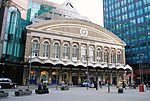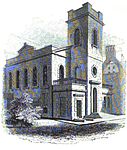The London Wall was a defensive wall first built by the Romans around the strategically important port town of Londinium in c. AD 200. It has origins as an initial mound wall and ditch from c. AD 100 and an initial fort, now called Cripplegate fort after the city gate (Cripplegate) that was positioned within its northern wall later on, built in 120-150 where it was then expanded upon by Roman builders into a city-wide defence. Over time, as Roman influence waned through the departure of the Roman army in c. 410, their withdrawal led to its disrepair, as political power on the island dispersed through the Heptarchy (seven kingdoms) period of Anglo-Saxon England. From the conquest of William the Conqueror, successive medieval restorations and repairs to its use have been undertaken. This wall largely defined the boundaries of the City of London until the later Middle Ages, when population rises and the development of towns around the city blurred the perimeter.Events such as the Wars of the Roses also played a part in the wall's development. This can be seen upon fragments of wall in the distinctive bricks used to increase its height through the diaper pattern bricks characteristic of the Tudor period and added crenellated battlements. Throughout its existence, the wall has served multiple purposes such as fortification, controlling the population, and acting as a ceremonial boundary for the city.
From the 18th century onward, the expansion of the City of London saw large parts of the wall demolished, including its city gates, to improve traffic flow; or incorporated into new or existing buildings. Over time, parts of the wall have been lost through this development, although archeological and conservation efforts from the Second World War onward have helped to preserve sections of the city wall as scheduled monuments.
Like most other city walls around England, and unlike rare examples such as York, the London Wall largely no longer exists, most of its foundations and/or surviving structures having been either buried underground or removed. Its existence, though, can still be seen through a number of uncovered and/ or preserved structures, records (see interactive map), and within modern urban architecture like the London Wall Road that echos the perimeter of the northern section of the London Wall.
See source Wikidata query. See this map in big, interactive, with illustrations and more











